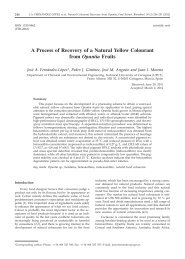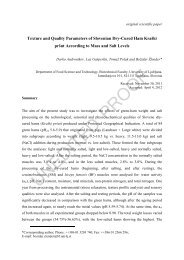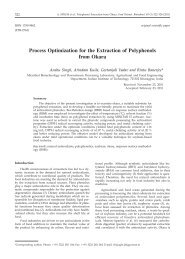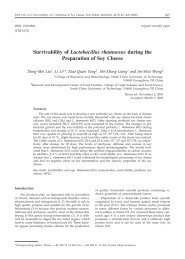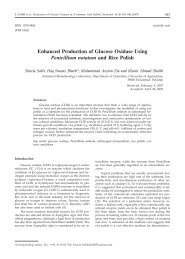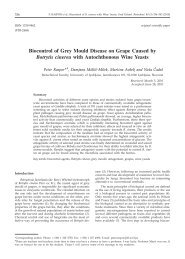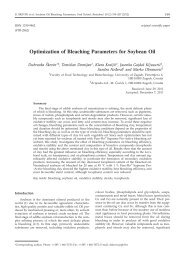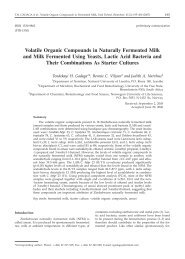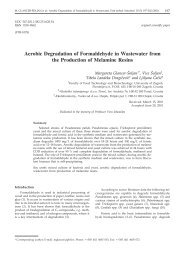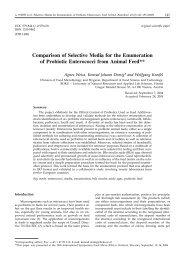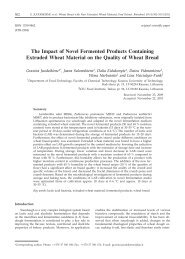Antibiotic Resistance Mechanisms in Bacteria: Biochemical and ...
Antibiotic Resistance Mechanisms in Bacteria: Biochemical and ...
Antibiotic Resistance Mechanisms in Bacteria: Biochemical and ...
You also want an ePaper? Increase the reach of your titles
YUMPU automatically turns print PDFs into web optimized ePapers that Google loves.
S. D@IDI] et al.: <strong>Antibiotic</strong> <strong>Resistance</strong> <strong>in</strong> <strong>Bacteria</strong>, Food Technol. Biotechnol. 46 (1) 11–21 (2008)11ISSN 1330-9862(FTB-1931)review<strong>Antibiotic</strong> <strong>Resistance</strong> <strong>Mechanisms</strong> <strong>in</strong> <strong>Bacteria</strong>:<strong>Biochemical</strong> <strong>and</strong> Genetic AspectsSenka D`idi} 1 , Jagoda [u{kovi} 2* <strong>and</strong> Bla`enka Kos 21 Ru|er Bo{kovi} Institute, Department of Molecular Genetics, POB 180, HR-10 002 Zagreb, Croatia2 Laboratory for <strong>Antibiotic</strong>, Enzyme, Probiotic <strong>and</strong> Starter Culture Technology, Faculty of FoodTechnology <strong>and</strong> Biotechnology, University of Zagreb, POB 625, HR-10 001 Zagreb, CroatiaReceived: June 5, 2007Accepted: November 19, 2007SummaryS<strong>in</strong>ce the discovery <strong>and</strong> subsequent widespread use of antibiotics, a variety of bacterialspecies of human <strong>and</strong> animal orig<strong>in</strong> have developed numerous mechanisms that renderbacteria resistant to some, <strong>and</strong> <strong>in</strong> certa<strong>in</strong> cases to nearly all antibiotics. There are manyimportant pathogens that are resistant to multiple antibiotic classes, <strong>and</strong> <strong>in</strong>fections causedby multidrug resistant (MDR) organisms are limit<strong>in</strong>g treatment options <strong>and</strong> compromis<strong>in</strong>geffective therapy. So the emergence of antibiotic-resistant pathogens <strong>in</strong> bacterial populationsis a relevant field of study <strong>in</strong> molecular <strong>and</strong> evolutionary biology, <strong>and</strong> <strong>in</strong> medicalpractice. There are two ma<strong>in</strong> aspects to the biology of antimicrobial resistance. One is concernedwith the development, acquisition <strong>and</strong> spread of the resistance gene itself. The otheris the specific biochemical mechanism conveyed by this resistance gene. In this reviewwe present some recent data on molecular mechanisms of antibiotic resistance.Key words: antibiotic resistance, multidrug resistance, antibiotic <strong>in</strong>activation, target modification,drug efflux, membrane permeability changes, hypermutators, horizontal gene transferIntroductionInfections have been the major cause of diseasethroughout the history of human population. With the<strong>in</strong>troduction of antibiotics, it was thought that this problemshould disappear. However, bacteria have been ableto evolve to become resistant to antibiotics (1–3). The <strong>in</strong>crease<strong>in</strong> antibiotic resistance has been attributed to acomb<strong>in</strong>ation of microbial characteristics, the selectivepressure of antibiotic use <strong>and</strong> social <strong>and</strong> technical changesthat enhance the transmission of resistant organisms.The grow<strong>in</strong>g threat from resistant organisms calls forconcerted action to prevent the emergence of new resistantstra<strong>in</strong>s <strong>and</strong> the spread of exist<strong>in</strong>g ones (4).Recent extensive reviews on the application of antibiotics<strong>in</strong> human <strong>and</strong> veter<strong>in</strong>ary medic<strong>in</strong>e (5–7), agriculture(8) <strong>and</strong> aquaculture (9) have documented the enrichmentof antibiotic-resistant bacteria. Many procedures,use <strong>and</strong> misuse of antibiotics <strong>in</strong> man have resulted <strong>in</strong>antibiotic-resistant bacteria. The nutritive <strong>and</strong> therapeuticantibiotic treatment of farm animals amounts to a halfof the world’s antibiotic output <strong>and</strong> has also resulted <strong>in</strong>antibiotic-resistant bacteria. Evidence is accumulat<strong>in</strong>g tosupport the hypothesis that antibiotic-resistant bacteriafrom poultry, pigs <strong>and</strong> cattle enter the food supply, canbe found <strong>in</strong> human food (10–13), colonize human digestivetract <strong>and</strong> transfer resistance genes to human commensals.There have been very few systematic studies to <strong>in</strong>vestigatethe acquired antibiotic resistance <strong>in</strong> lactic acidbacteria (LAB) of food orig<strong>in</strong>. However, they are latelyexp<strong>and</strong><strong>in</strong>g due to <strong>in</strong>creased <strong>in</strong>terest <strong>in</strong> probiotic lacticacid bacteria <strong>and</strong> genetic modification of LAB. WhenLAB live <strong>in</strong> a biotope regularly challenged by antibiotics(human or animal <strong>in</strong>test<strong>in</strong>e, bov<strong>in</strong>e udder), the acquired*Correspond<strong>in</strong>g author; Phone: ++385 1 4605 291; Fax: ++385 1 4836 424; E-mail: jsusko@pbf.hr
S. D@IDI] et al.: <strong>Antibiotic</strong> <strong>Resistance</strong> <strong>in</strong> <strong>Bacteria</strong>, Food Technol. Biotechnol. 46 (1) 11–21 (2008)13Biology of antibiotic resistance<strong>Biochemical</strong> aspects<strong>Antibiotic</strong> <strong>in</strong>activation- hydrolysis- group transfer- redox processTarget modification- peptidoglycan structure alteration- prote<strong>in</strong> structure <strong>in</strong>terference- DNA synthesis <strong>in</strong>terferenceEfflux pumps <strong>and</strong> OMpermeability changesTarget bypassGenetic aspectsMutations- spontaneous mutations- hypermutators- adaptive mutagenesisHorizontal genetransfer- plasmids- (conjugative) transposons- <strong>in</strong>tegronsFig. 1. <strong>Biochemical</strong> <strong>and</strong> genetic aspects of antibiotic resistancemechanisms <strong>in</strong> bacteriadirect <strong>in</strong>activation of the active antibiotic molecule (36);(ii) Target modification – alteration of the sensitivity tothe antibiotic by modification of the target (37); (iii)Efflux pumps <strong>and</strong> outer membrane (OM) permeabilitychanges – reduction of the concentration of drug withoutmodification of the compound itself (38); or (iv) Targetbypass – some bacteria become refractory to specificantibiotics by bypass<strong>in</strong>g the <strong>in</strong>activation of a given enzyme.This mode of resistance is observed <strong>in</strong> many trimethoprim-<strong>and</strong> sulfonamide-resistant bacteria. The exampleis <strong>in</strong> bypass<strong>in</strong>g <strong>in</strong>hibition of dihydrofolate reductase(DHFR) <strong>and</strong> dihydropteroate synthase (DHPS) enzymes(<strong>in</strong>volved <strong>in</strong> tetrahydrofolate biosynthesis). They are <strong>in</strong>hibitedby trimethoprim <strong>and</strong> sulfonamides, respectively.In several trimethoprim- <strong>and</strong> sulfonamide-resistant stra<strong>in</strong>s,a second enzyme that has low aff<strong>in</strong>ity for the <strong>in</strong>hibitorsis produced (34,39).There is an amaz<strong>in</strong>g diversity of antibiotic resistancemechanisms with<strong>in</strong> each of these four categories <strong>and</strong> as<strong>in</strong>gle bacterial stra<strong>in</strong> may possess several types of resistancemechanisms. Which of these mechanisms prevailsdepends on the nature of the antibiotic, its target site,the bacterial species <strong>and</strong> whether it is mediated by a resistanceplasmid or by a chromosomal mutation.<strong>Antibiotic</strong> <strong>in</strong>activationThe defence mechanisms with<strong>in</strong> the category of antibiotic<strong>in</strong>activation <strong>in</strong>clude the production of enzymesthat degrade or modify the drug itself. <strong>Biochemical</strong> strategiesare hydrolysis, group transfer, <strong>and</strong> redox mechanisms.<strong>Antibiotic</strong> <strong>in</strong>activation by hydrolysisMany antibiotics have hydrolytically susceptible chemicalbonds (e.g. esters <strong>and</strong> amides). Several enzymesare known to destroy antibiotic activity by target<strong>in</strong>g <strong>and</strong>cleav<strong>in</strong>g these bonds. These enzymes can often be excretedby the bacteria, <strong>in</strong>activat<strong>in</strong>g antibiotics beforethey reach their target with<strong>in</strong> the bacteria. The classicalhydrolytic amidases are the b-lactamases that cleave theb-lactam r<strong>in</strong>g of the penicill<strong>in</strong> <strong>and</strong> cephalospor<strong>in</strong> antibiotics.Many Gram-negative <strong>and</strong> Gram-positive bacteriaproduce such enzymes, <strong>and</strong> more than 200 differentb-lactamases have been identified. b-Lactamases areclassified <strong>in</strong>to four groups on the basis of functionalcharacteristics, <strong>in</strong>clud<strong>in</strong>g preferred antibiotic substrate.Cl<strong>in</strong>ical isolates often produce b-lactamases belong<strong>in</strong>g todifferent functional groups. They can be both chromosomal<strong>and</strong> plasmid-encoded b-lactamases transferredfrom different bacteria (40–43).Extended-spectrum b-lactamases (ESBLs) mediate resistanceto all penicill<strong>in</strong>s, third generation cephalospor<strong>in</strong>s(e.g. ceftazidime, cefotaxime, ceftriaxone) <strong>and</strong> aztreonam,but not cephamyc<strong>in</strong>s (cefoxit<strong>in</strong> <strong>and</strong> cefotetan)<strong>and</strong> carbapenems. ESBLs are very diverse: more than180 different ESBLs have been identified. They are mostcommonly detected <strong>in</strong> Escherichia coli, Klebsiella pneumoniae<strong>and</strong> Proteus mirabilis, but have also been found <strong>in</strong>other Enterobacteriaceae (44,45). The website http://www.lahey.org/Studies/ was established to st<strong>and</strong>ardize the nomenclaturefor the grow<strong>in</strong>g number of b-lactamases <strong>and</strong>provide references to sources for nucleotide <strong>and</strong> am<strong>in</strong>oacid sequence <strong>in</strong>formation (46).Other hydrolytic enzyme examples <strong>in</strong>clude esterasesthat have been l<strong>in</strong>ked to macrolide antibiotic resistance<strong>and</strong> r<strong>in</strong>g-open<strong>in</strong>g epoxidases caus<strong>in</strong>g resistance to fosfomyc<strong>in</strong>(47–49).<strong>Antibiotic</strong> <strong>in</strong>activation by group transferThe most diverse family of resistant enzymes is thegroup of transferases. These enzymes <strong>in</strong>activate antibiotics(am<strong>in</strong>oglycosides, chloramphenicol, streptogram<strong>in</strong>,macrolides or rifampic<strong>in</strong>) by chemical substitution (adenylyl,phosphoryl or acetyl groups are added to the peripheryof the antibiotic molecule). The modified antibioticsare affected <strong>in</strong> their b<strong>in</strong>d<strong>in</strong>g to a target. Chemicalstrategies <strong>in</strong>clude O-acetylation <strong>and</strong> N-acetylation (50–52), O-phosphorylation (53–55), O-nucleotidylation (56,57),O-ribosylation (58), O-glycosylation, <strong>and</strong> thiol transfer.These covalent modification strategies all require a co--substrate for their activity (ATP, acetyl-CoA, NAD + ,UDP-glucose, or glutathione) <strong>and</strong> consequently theseprocesses are restricted to the cytoplasm.<strong>Antibiotic</strong> <strong>in</strong>activation by redox processThe oxidation or reduction of antibiotics has been<strong>in</strong>frequently exploited by pathogenic bacteria. However,there are a few of examples of this strategy (59–61). Oneis the oxidation of tetracycl<strong>in</strong>e antibiotics by the TetXenzyme. Streptomyces virg<strong>in</strong>iae, producer of the type Astreptogram<strong>in</strong> antibiotic virg<strong>in</strong>iamyc<strong>in</strong> M 1 , protects itselffrom its own antibiotic by reduc<strong>in</strong>g a critical ketonegroup to an alcohol at position 16.Target modificationThe second major resistance mechanism is the modificationof the antibiotic target site so that the antibioticis unable to b<strong>in</strong>d properly. Because of the vital cellularfunctions of the target sites, organisms cannot evadeantimicrobial action by dispens<strong>in</strong>g with them entirely.
14 S. D@IDI] et al.: <strong>Antibiotic</strong> <strong>Resistance</strong> <strong>in</strong> <strong>Bacteria</strong>, Food Technol. Biotechnol. 46 (1) 11–21 (2008)However, it is possible for mutational changes to occur<strong>in</strong> the target that reduce susceptibility to <strong>in</strong>hibitionwhilst reta<strong>in</strong><strong>in</strong>g cellular function (62).In some cases, the modification <strong>in</strong> target structureneeded to produce resistance requires other changes <strong>in</strong>the cell to compensate for the altered characteristics ofthe target. This is the case <strong>in</strong> the acquisition of the penicill<strong>in</strong>-b<strong>in</strong>d<strong>in</strong>gprote<strong>in</strong> 2a (PBP2a) transpeptidase <strong>in</strong> Staphylococcusaureus that results <strong>in</strong> resistance to methicill<strong>in</strong>(methicill<strong>in</strong>-resistant S. aureus, MRSA) <strong>and</strong> to most otherb-lactam antibiotics. To save the efficiency of peptidoglycanbiosynthesis, PBP2a needs alterations <strong>in</strong> the composition<strong>and</strong> structure of peptidoglycan, which <strong>in</strong>volvesfunction<strong>in</strong>g of a number of additional genes (39,63,64).Peptidoglycan structure alterationThe peptidoglycan component of the bacterial cellwall provides an excellent selective target for the antibiotics.It is essential for the growth <strong>and</strong> survival of mostbacteria. Consequently, enzymes <strong>in</strong>volved <strong>in</strong> synthesis <strong>and</strong>assembly of the peptidoglycan component of the bacterialcell wall provide excellent targets for selective <strong>in</strong>hibition.The presence of mutations <strong>in</strong> the penicill<strong>in</strong>-b<strong>in</strong>d<strong>in</strong>gdoma<strong>in</strong> of penicill<strong>in</strong>-b<strong>in</strong>d<strong>in</strong>g prote<strong>in</strong>s (PBPs) results<strong>in</strong> decreased aff<strong>in</strong>ity to b-lactam antibiotics. Alterationsamong PBPs result <strong>in</strong> ampicill<strong>in</strong> resistance among Enterococcusfaecium, <strong>and</strong> penicill<strong>in</strong> resistance among Streptococcuspneumoniae (65–67). <strong>Resistance</strong> to methicill<strong>in</strong> <strong>and</strong>oxacill<strong>in</strong> <strong>in</strong> S. aureus is associated with acquisition of amobile genetic element called SCCmec, which conta<strong>in</strong>sthe mecA resistance gene. The mecA determ<strong>in</strong>ant encodesPBP2a, a new penicill<strong>in</strong>-b<strong>in</strong>d<strong>in</strong>g prote<strong>in</strong> dist<strong>in</strong>ct from thePBPs normally found <strong>in</strong> S. aureus. PBP2a is highly resistantto <strong>in</strong>hibition by all cl<strong>in</strong>ically used b-lactams <strong>and</strong> rema<strong>in</strong>sactive to ma<strong>in</strong>ta<strong>in</strong> cell wall synthesis at normallylethal b-lactam concentrations (32).Glycopeptides such as vancomyc<strong>in</strong> <strong>in</strong>hibit cell wallsynthesis of Gram-positive bacteria by b<strong>in</strong>d<strong>in</strong>g C-term<strong>in</strong>alacyl-D-alanyl-D-alan<strong>in</strong>e (acyl-D-Ala-D-Ala)-conta<strong>in</strong><strong>in</strong>gresidues <strong>in</strong> peptidoglycan precursors. <strong>Resistance</strong> isachieved by alter<strong>in</strong>g the target site by chang<strong>in</strong>g the D--Ala-D-Ala to D-alanyl-D-lactate (D-Ala-D-Lac) or D-alanyl--D-ser<strong>in</strong>e (D-Ala-D-Ser) at the C-term<strong>in</strong>us, which <strong>in</strong>hibitsthe b<strong>in</strong>d<strong>in</strong>g of vancomyc<strong>in</strong> (68-70). As a consequence,the aff<strong>in</strong>ity of vancomyc<strong>in</strong> for the new term<strong>in</strong>us is 1000times lower than for the native peptidoglycan precursor<strong>in</strong> the case of D-Ala-D-Lac. Dissem<strong>in</strong>ation of glycopeptideresistance <strong>in</strong> Gram-positive cocci can occur at thelevel of the bacteria (clonal spread), replicons (plasmidepidemics) or of the genes (transposons). Glycopeptide(vancomyc<strong>in</strong>) resistance can be <strong>in</strong>tr<strong>in</strong>sic (VanC-type resistance)or acquired, present only <strong>in</strong> certa<strong>in</strong> isolates belong<strong>in</strong>gto the same species (VanA, B, D, C, E <strong>and</strong> Gtypes of vancomyc<strong>in</strong> resistance) (71).Prote<strong>in</strong> synthesis <strong>in</strong>terferenceA wide range of antibiotics <strong>in</strong>terfere with prote<strong>in</strong>synthesis on different levels of prote<strong>in</strong> metabolism. Theresistance to antibiotics that <strong>in</strong>terfere with prote<strong>in</strong> synthesis(am<strong>in</strong>oglycosides, tetracycl<strong>in</strong>es, macrolides, chloramphenicol,fusidic acid, mupiroc<strong>in</strong>, streptogram<strong>in</strong>s,oxazolid<strong>in</strong>ones) or transcription via RNA polymerase(the rifamyc<strong>in</strong>s) is achieved by modification of the specifictarget (39).The macrolide, l<strong>in</strong>cosamide <strong>and</strong> streptogram<strong>in</strong> Bgroup of antibiotics block prote<strong>in</strong> synthesis <strong>in</strong> bacteriaby b<strong>in</strong>d<strong>in</strong>g to the 50S ribosomal subunit (72–74). <strong>Resistance</strong>to these antibiotics is referred to as MLS(B) typeresistance <strong>and</strong> occurs <strong>in</strong> a wide range of Gram-positivebacteria. It results from a post-transcriptional modificationof the 23S rRNA component of the 50S ribosomalsubunit (75). Mutations <strong>in</strong> 23S rRNA close to the sites ofmethylation have also been associated with resistance tothe macrolide group of antibiotics <strong>in</strong> a range of organisms.In addition to multiple mutations <strong>in</strong> the 23S rRNA,alterations <strong>in</strong> the L4 <strong>and</strong> L22 prote<strong>in</strong>s of the 50S subunithave been reported <strong>in</strong> macrolide-resistant S. pneumoniae(76). The mechanism of action of oxazolid<strong>in</strong>ones (for example,l<strong>in</strong>ezolid) <strong>in</strong>volves multiple stages <strong>in</strong> the prote<strong>in</strong>synthesis (77). Although they b<strong>in</strong>d to the 50S subunit,the effects <strong>in</strong>clude <strong>in</strong>hibition of formation of the <strong>in</strong>itiationcomplex <strong>and</strong> <strong>in</strong>terference with translocation of peptidyl-tRNAfrom the A site to the P site. <strong>Resistance</strong> hasbeen reported <strong>in</strong> a number of organisms <strong>in</strong>clud<strong>in</strong>g enterococci<strong>and</strong> is l<strong>in</strong>ked to mutations <strong>in</strong> the 23S rRNA result<strong>in</strong>g<strong>in</strong> decreased aff<strong>in</strong>ity for b<strong>in</strong>d<strong>in</strong>g (78).Mutations <strong>in</strong> the 16S rRNA gene confer resistance tothe am<strong>in</strong>oglycosides (79). Chromosomally acquired streptomyc<strong>in</strong>resistance <strong>in</strong> M. tuberculosis is frequently due tomutations <strong>in</strong> the rpsL gene encod<strong>in</strong>g the ribosomal prote<strong>in</strong>S12. Microorganisms that produce am<strong>in</strong>oglycosideshave developed mechanism of high level antibiotic resistanceby posttranscriptional methylation of 16S rRNA <strong>in</strong>the am<strong>in</strong>oglycoside b<strong>in</strong>d<strong>in</strong>g site. This mechanism of resistancehas recently been reported <strong>in</strong> human pathogensfrom nosocomial <strong>in</strong>fections <strong>and</strong> animal isolates (80).DNA synthesis <strong>in</strong>terferenceFluoroqu<strong>in</strong>olones <strong>in</strong>teract with the DNA gyrase <strong>and</strong>topoisomerase IV enzymes <strong>and</strong> prevent DNA replication<strong>and</strong> transcription. <strong>Resistance</strong> is conferred by mutations<strong>in</strong> specific regions of the structural genes that sufficientlyalter these enzymes prevent<strong>in</strong>g the b<strong>in</strong>d<strong>in</strong>g of antibiotics(81,82). The most common mutations <strong>in</strong> this regioncause resistance through decreased drug aff<strong>in</strong>ity for thealtered gyrase–DNA complex (83–85).Efflux pumps <strong>and</strong> outer membrane (OM) permeabilityThe efflux pumps are the membrane prote<strong>in</strong>s thatexport the antibiotics out of the cell <strong>and</strong> keep its <strong>in</strong>tracellularconcentrations at low levels. Reduced outer membrane(OM) permeability results <strong>in</strong> reduced antibiotic uptake.The reduced uptake <strong>and</strong> active efflux <strong>in</strong>duce lowlevel resistance <strong>in</strong> many cl<strong>in</strong>ically important bacteria (86).Efflux pumpsEfflux pumps affect all classes of antibiotics, especiallythe macrolides, tetracycl<strong>in</strong>es, <strong>and</strong> fluoroqu<strong>in</strong>olonesbecause these antibiotics <strong>in</strong>hibit different aspectsof prote<strong>in</strong> <strong>and</strong> DNA biosynthesis <strong>and</strong> therefore must be<strong>in</strong>tracellular to exert their effect. Efflux pumps vary <strong>in</strong>both their specificity <strong>and</strong> mechanism (87,88). Althoughsome are drug-specific, many efflux systems are multidrugtransporters that are capable of expell<strong>in</strong>g a widespectrum of structurally unrelated drugs, thus contribut-
S. D@IDI] et al.: <strong>Antibiotic</strong> <strong>Resistance</strong> <strong>in</strong> <strong>Bacteria</strong>, Food Technol. Biotechnol. 46 (1) 11–21 (2008)15<strong>in</strong>g significantly to bacterial multidrug resistance (MDR)(89). Inducible multidrug efflux pumps are responsiblefor the <strong>in</strong>tr<strong>in</strong>sic antibiotic resistance of many organisms,<strong>and</strong> mutation of the regulatory elements that control theproduction of efflux pumps can lead to an <strong>in</strong>crease <strong>in</strong>antibiotic resistance. For example, the MexAB-OprM effluxpump <strong>in</strong> Pseudomonas aerug<strong>in</strong>osa is normally positivelyregulated by the presence of drugs, but mutations<strong>in</strong> its regulator (mexR) lead to the overexpression ofMexAB-OprM, which confers <strong>in</strong>creased resistance to antibioticssuch as b-lactams (90–92). Both Gram-positive<strong>and</strong> Gram-negative bacteria can possess s<strong>in</strong>gle-drug<strong>and</strong>/or multiple drug efflux pumps (93,94).<strong>Bacteria</strong>l drug efflux transporters are currently classified<strong>in</strong>to five families (95,96). The major facilitator superfamily(MFS) <strong>and</strong> the adenos<strong>in</strong>e triphosphate (ATP)--b<strong>in</strong>d<strong>in</strong>g cassette (ABC) superfamily are very large <strong>and</strong>the other three are smaller families: the small multidrugresistance (SMR) family, the resistance-nodulation-cell division(RND) superfamily <strong>and</strong> the multidrug <strong>and</strong> toxiccompound extrusion (MATE) family. Efflux transporterscan be further classified <strong>in</strong>to s<strong>in</strong>gle or multicomponentpumps (97–99). S<strong>in</strong>gle component pumps transport theirsubstrates across the cytoplasmic membrane. Multicomponentpumps, found <strong>in</strong> Gram-negative organisms, function<strong>in</strong> association with a periplasmic membrane fusionprote<strong>in</strong> (MFP) component <strong>and</strong> an outer membrane prote<strong>in</strong>(OMP) component, <strong>and</strong> efflux substrates across theentire cell envelope.Furthermore, the regulators of efflux systems maybe attractive drug targets themselves. The regulators <strong>in</strong>volved<strong>in</strong> efflux gene expression are either local or globalregulators. Many pump component-encod<strong>in</strong>g operonsconta<strong>in</strong> a physically l<strong>in</strong>ked regulatory gene. Someefflux pumps are known to be regulated by two-componentsystems. These systems mediate the adaptive responsesof bacterial cells to their environment. Expression ofvarious efflux pumps is also controlled by different globalregulators. So far, several global transcriptional activators,<strong>in</strong>clud<strong>in</strong>g MarA, SoxS <strong>and</strong> Rob, have been shownto be <strong>in</strong>volved <strong>in</strong> the regulation of expression of this system(97–99).Outer membrane (OM) permeability changesGram-negative bacteria possess an outer membraneconsist<strong>in</strong>g of an <strong>in</strong>ner layer conta<strong>in</strong><strong>in</strong>g phospholipids <strong>and</strong>an outer layer conta<strong>in</strong><strong>in</strong>g the lipid A moiety of lipopolysaccharides(LPS). This composition of the outer membrane(OM) slows down drug penetration, <strong>and</strong> transportacross the OM is achieved by por<strong>in</strong> prote<strong>in</strong>s that formwater-filled channels. Drug molecules can penetrate theOM employ<strong>in</strong>g one of the follow<strong>in</strong>g modes: by diffusionthrough por<strong>in</strong>s, by diffusion through the bilayer or byself-promoted uptake. The mode of entry employed by adrug molecule largely depends on its chemical composition.For example, hydrophilic compounds either enterthe periplasm through por<strong>in</strong>s (e.g. b-lactams) or self-promoteduptake (am<strong>in</strong>oglycosides). <strong>Antibiotic</strong>s such as b--lactams, chloramphenicol <strong>and</strong> fluoroqu<strong>in</strong>olones enter theGram-negative outer membrane via por<strong>in</strong>s. As such,changes <strong>in</strong> por<strong>in</strong> copy number, size or selectivity will alterthe rate of diffusion of these antibiotics (100–104).The role of LPS as a barrier to antibiotics is welldocumented. Mutations <strong>in</strong> LPS that result <strong>in</strong> antibiotichypersusceptibility have been reported. Stra<strong>in</strong>s of E. coli<strong>and</strong> S. enterica serovar Typhimurium defective <strong>in</strong> LPShave been found to be at least 4-fold more susceptible toerythromyc<strong>in</strong>, roxithromyc<strong>in</strong>, clarithromyc<strong>in</strong> <strong>and</strong> azithromyc<strong>in</strong>than the wild-type stra<strong>in</strong>s (105,106).Genetics of <strong>Antibiotic</strong> <strong>Resistance</strong>Studies of a wide variety of bacterial pathogens haveidentified numerous genetic loci associated with antibioticresistance. For some types of resistance there is alarge diversity of responsible genetic determ<strong>in</strong>ants.<strong>Resistance</strong> can be an <strong>in</strong>tr<strong>in</strong>sic property of the bacteriathemselves or it can be acquired. Acquired bacterialantibiotic resistance can result from a mutation of cellulargenes, the acquisition of foreign resistance genes or acomb<strong>in</strong>ation of these two mechanisms. Thus, there aretwo ma<strong>in</strong> ways of acquir<strong>in</strong>g antibiotic resistance: i)through mutation <strong>in</strong> different chromosomal loci <strong>and</strong> ii)through horizontal gene transfer (i.e. acquisition of resistancegenes from other microorganisms). This raises severalquestions about the evolution <strong>and</strong> ecology of antibioticresistance genes. Phylogenetic <strong>in</strong>sights <strong>in</strong>to the evolution<strong>and</strong> diversity of several antibiotic resistance genessuggest that at least some of these genes have a longevolutionary history of diversification that began wellbefore the ðantibiotic era’ (107).MutationsSpontaneous mutationsExplor<strong>in</strong>g the orig<strong>in</strong>s of resistant mutants beganwith the antibiotic era <strong>in</strong> 1940s, when researchers performedclassical experiments prov<strong>in</strong>g that mutationsconferr<strong>in</strong>g resistance to certa<strong>in</strong> antibiotics arise prior toor <strong>in</strong> the absence of any selective pressure. These mutationevents occur r<strong>and</strong>omly as replication errors or an<strong>in</strong>correct repair of a damaged DNA <strong>in</strong> actively divid<strong>in</strong>gcells. They are called growth dependent mutations (spontaneousmutations) <strong>and</strong> present an important mode ofgenerat<strong>in</strong>g antibiotic resistance (108).<strong>Antibiotic</strong> resistance occurs by nucleotide po<strong>in</strong>t mutationswhich are at the same time growth permissive<strong>and</strong> are able to produce a resistance phenotype (109).For <strong>in</strong>stance, qu<strong>in</strong>olone resistance phenotype <strong>in</strong> Escherichiacoli is a result of changes <strong>in</strong> at least seven positions<strong>in</strong> the gyrA gene, but <strong>in</strong> only three positions <strong>in</strong> theparC gene (110,111). A variety of genes can be <strong>in</strong>volved<strong>in</strong> antibiotic resistance either because there are severaldifferent targets, access, or protection pathways for theantibiotic <strong>in</strong> the bacterial cell or because each pathwayrequires the expression of several genes.There is a substantial number of biochemical mechanismsof antibiotic resistance that are based on mutationalevents, like the mutations of the sequences of genesencod<strong>in</strong>g the target of certa<strong>in</strong> antibiotics (for <strong>in</strong>stance, resistanceto rifamic<strong>in</strong>s <strong>and</strong> fluoroqu<strong>in</strong>olones are causedby mutations <strong>in</strong> the genes encod<strong>in</strong>g the targets of thesetwo molecules, RpoB <strong>and</strong> DNA-topoisomerases, respectively)(112,113). The variation <strong>in</strong> the expression of antibioticuptake or of the efflux systems may also be modi-
20 S. D@IDI] et al.: <strong>Antibiotic</strong> <strong>Resistance</strong> <strong>in</strong> <strong>Bacteria</strong>, Food Technol. Biotechnol. 46 (1) 11–21 (2008)reduced susceptibilities to vancomyc<strong>in</strong> <strong>and</strong> other glycopeptides,J. Cl<strong>in</strong>. Microbiol. 36 (1998) 1020–1027.70. M.A. Cooper, M.T. Fior<strong>in</strong>i, C. Abell, D.H. Williams, B<strong>in</strong>d<strong>in</strong>gof vancomyc<strong>in</strong> group antibiotics to D-alan<strong>in</strong>e <strong>and</strong> D-lactatepresent<strong>in</strong>g self-assembled monolayers, Bioorg. Med.Chem. 8 (2000) 2609–2616.71. P. Courval<strong>in</strong>, Genetics of glycopeptide resistance <strong>in</strong> Gram--positive pathogens, Int. J. Med. Microbiol. 294 (2005) 479–486.72. B. Weisblum, Macrolide resistance, Drug Resist. Update, 1(1998) 29–41.73. P. Spigaglia, P. Mastrantonio, Analysis of macrolide-l<strong>in</strong>cosamide-streptogram<strong>in</strong>B (MLS B ) resistance determ<strong>in</strong>ant <strong>in</strong>stra<strong>in</strong>s of Clostridium difficile, Microb. Drug Resist. 8 (2002)45–53.74. G. Ackermann, A. Degner, S.H. Cohen, J. Silva Jr., A.C.Rodloff, Prevalence <strong>and</strong> association of macrolide-l<strong>in</strong>cosamide-streptogram<strong>in</strong>B (MLS B ) resistance with resistance tomoxifloxac<strong>in</strong> <strong>in</strong> Clostridium difficile, J. Antimicrob. Chemother.51 (2003) 599–603.75. B. Weisblum, Erythromyc<strong>in</strong> resistance by ribosome modification,Antimicrob. Agents Chemother. 39 (1995) 577–585.76. A. Canu, B. Malbruny, M. Coquemont, T.A. Davies, P.C.Appelbaum, R. Leclercq, Diversity of ribosomal mutationsconferr<strong>in</strong>g resistance to macrolides, cl<strong>in</strong>damyc<strong>in</strong>, streptogram<strong>in</strong>,<strong>and</strong> telithromyc<strong>in</strong> <strong>in</strong> Streptococcus pneumoniae,Antimicrob. Agents Chemother. 46 (2002) 125–131.77. B. Bozdogan, P.C. Appelbaum, Oxazolid<strong>in</strong>ones: Activity,mode of action, <strong>and</strong> mechanism of resistance, Int. J. Antimicrob.Agents, 23 (2004) 113–119.78. G. Wang, D.E. Taylor, Site-specific mutations <strong>in</strong> the 23SrRNA gene of Helicobacter pylori confer two types of resistanceto macrolide–l<strong>in</strong>cosamide–streptogram<strong>in</strong> B antibiotics,Antimicrob. Agents Chemother. 42 (1998) 1952–1958.79. Y. Suzuki, C. Katsukawa, A. Tamaru, C. Abe, M. Mak<strong>in</strong>o,Y. Mizuguchi, H. Taniguchi, Detection of kanamyc<strong>in</strong>-resistantMycobacterium tuberculosis by identify<strong>in</strong>g mutations<strong>in</strong> the 16S rRNA gene, J. Cl<strong>in</strong>. Microbiol. 36 (1998) 1220–1225.80. G. Maravi} Vlahovi~ek, S. ^ubrilo, K.L. Tkaczuk, J.M. Bujnicki,Model<strong>in</strong>g <strong>and</strong> experimental analyses reveal a two--doma<strong>in</strong> structure <strong>and</strong> am<strong>in</strong>o acids important for the activityof am<strong>in</strong>oglycoside resistance methyltransferase Sgm,Biochim. Biophys. Acta (<strong>in</strong> press).81. A.B. Khodursky, E.L. Zechiedrich, N.R. Cozzarelli, TopoisomeraseIV is a target of qu<strong>in</strong>olones <strong>in</strong> Escherichia coli,Proc. Natl. Acad. Sci. USA, 92 (1995) 11801–11805.82. D. Ince, X. Zhang, L.C. Silver, D.C. Hooper, Dual target<strong>in</strong>gof DNA gyrase <strong>and</strong> topoisomerase IV: Target <strong>in</strong>teractionsof garenoxac<strong>in</strong> (BMS-284756, T-3811ME), a new desfluoroqu<strong>in</strong>olone,Antimicrob. Agents Chemother. 46 (2002) 3370–3380.83. C.J. Willmott, A. Maxwell, A s<strong>in</strong>gle po<strong>in</strong>t mutation <strong>in</strong> theDNA gyrase A prote<strong>in</strong> greatly reduces b<strong>in</strong>d<strong>in</strong>g of fluoroqu<strong>in</strong>olonesto the gyrase–DNA complex, Antimicrob. AgentsChemother. 37 (1993) 126–127.84. D.C. Hooper, <strong>Mechanisms</strong> of fluoroqu<strong>in</strong>olone resistance,Drug Resist. Update, 2 (1999) 38–55.85. G.M. Eliopoulos, Qu<strong>in</strong>olone resistance mechanisms <strong>in</strong> pneumococci,Cl<strong>in</strong>. Infect. Dis. (Suppl.), 38 (2004) 350–356.86. H. Nikaido, Prevention of drug access to bacterial targets:Permeability barriers <strong>and</strong> active efflux, Science, 264 (1994)382–388.87. H. Nikaido, H.I. Zgurskaya, <strong>Antibiotic</strong> efflux mechanisms,Curr. Op<strong>in</strong>. Infect. Dis. 12 (1999) 529–536.88. M.A. Webber, L.J. Piddock, The importance of efflux pumps<strong>in</strong> bacterial antibiotic resistance, J. Antimicrob. Chemother.51 (2003) 9–11.89. H.W. van Veen, W.N. Kon<strong>in</strong>gs, Drug efflux prote<strong>in</strong>s <strong>in</strong> multidrugresistant bacteria, Biol. Chem. 378 (1997) 769–777.90. K. Poole, Multidrug efflux pumps <strong>and</strong> antimicrobial resistance<strong>in</strong> P. aerug<strong>in</strong>osa <strong>and</strong> related organisms, J. Mol. Microbiol.Biotechnol. 3 (2001) 225–264.91. N. Gotoh, H. Tsujimoto, K. Poole, J. Yamagishi, T. Nish<strong>in</strong>o,The outer membrane prote<strong>in</strong> OprM of Pseudomonas aerug<strong>in</strong>osais encoded by oprK of the mexA-mexB-oprKmultidrug resistance operon, Antimicrob. Agents Chemother.39 (1995) 2567–2569.92. T. Köhler, S.F. Epp, L.K. Curty, J.C. Pechère, Characterizationof MexT, the regulator of the MexE-MexF-OprN multidrugefflux system of Pseudomonas aerug<strong>in</strong>osa, J. Bacteriol.181 (1999) 6300–6305.93. K.P. Langton, P.J.F. Henderson, R.B. Herbert, <strong>Antibiotic</strong> resistance:Multidrug efflux prote<strong>in</strong>s, a common transportmechanism?, Nat. Prod. Rep. 22 (2005) 439–451.94. M. Putman, H.W. van Veen, W.N. Kon<strong>in</strong>gs, Molecular propertiesof bacterial multidrug transporters, Microbiol. Mol.Biol. Rev. 64 (2000) 672–693.95. S.S. Pao, I.T. Paulsen, M.H. Saier Jr., Major facilitator superfamily,Microbiol. Mol. Biol. Rev. 62 (1998) 1–34.96. H.W. van Veen, W.N. Kon<strong>in</strong>gs, The ABC family of multidrugtransporters <strong>in</strong> microorganisms, Biochim. Biophys.Acta, 1365 (1998) 31–36.97. H. Okusu, D. Ma, H. Nikaido, AcrAB efflux pump plays amajor role <strong>in</strong> the antibiotic resistance phenotype of Escherichiacoli multiple-antibiotic-resistance (Mar) mutants, J.Bacteriol. 178 (1996) 306–308.98. M.J. Fath, R. Kolter, ABC transporters: <strong>Bacteria</strong>l exporters,Microbiol. Rev. 57 (1993) 995–1017.99. C. Ma, G. Chang, Structure of the multidrug resistance effluxtransporter EmrE from Escherichia coli, Proc. Natl. Acad.Sci. USA, 101 (2004) 2852–2857.100. H. Nikaido, Molecular basis of bacterial outer membranepermeability revisited, Microbiol. Mol. Biol. Rev. 67 (2003)593–656.101. S.P. Denyer, J.Y. Maillard, Cellular impermeability <strong>and</strong> uptakeof biocides <strong>and</strong> antibiotics <strong>in</strong> Gram-negative bacteria,J. Appl. Microbiol. (Suppl.) 92 (2002) 35–45.102. J. Chevalier, J.M. Pages, M. Mallea, In vivo modification ofpor<strong>in</strong> activity conferr<strong>in</strong>g antibiotic resistance to Enterobacteraerogenes, Biochem. Biophys. Res. Commun. 266 (1999)248–251.103. E. Dé, A. Baslé, M. Jaqu<strong>in</strong>od, N. Sa<strong>in</strong>t, M. Malléa, G. Molle,J.M. Pagès, A new mechanism of antibiotic resistance<strong>in</strong> Enterobacteriaceae <strong>in</strong>duced by a structural modificationof the major por<strong>in</strong>, Mol. Microbiol. 41 (2001) 189–198.104. R.E. Hancock, F.S. Br<strong>in</strong>kman, Function of Pseudomonas por<strong>in</strong>s<strong>in</strong> uptake <strong>and</strong> efflux, Annu. Rev. Microbiol. 56 (2002)17–38.105. A. Wiese, K. Br<strong>and</strong>enburg, A.J. Ulmer, U. Seydel, S. Müller--Loennies, The dual role of lipopolysaccharide as effector<strong>and</strong> target molecule, Biol. Chem. 380 (1999) 767–784.106. M. Vaara, Outer membrane permeability barrier to azithromyc<strong>in</strong>,clarithromyc<strong>in</strong>, <strong>and</strong> roxithromyc<strong>in</strong> <strong>in</strong> Gram-negativeenteric bacteria, Antimicrob. Agents Chemother. 37 (1993)354–356.107. R.I. Am<strong>in</strong>ov, R.I. Mackie, Evolution <strong>and</strong> ecology of antibioticresistance genes, FEMS Microbiol. Lett. 271 (2007)147– 161.108. R. Kra{ovec, I. Jerman, <strong>Bacteria</strong>l multicellularity as a possiblesource of antibiotic resistance, Med. Hypotheses, 60(2003) 484–488.109. N. Woodford, M.J. Ell<strong>in</strong>gton, The emergence of antibioticresistance by mutation, Cl<strong>in</strong>. Microbiol. Infect. 13 (2007) 5–18.
S. D@IDI] et al.: <strong>Antibiotic</strong> <strong>Resistance</strong> <strong>in</strong> <strong>Bacteria</strong>, Food Technol. Biotechnol. 46 (1) 11–21 (2008)21110. D.C. Hooper, <strong>Mechanisms</strong> of fluoroqu<strong>in</strong>olone resistance,Drug Resist. Update, 2 (1999) 38–55.111. S. Nakamura, M. Nakamura, T. Kojima, H. Yoshida, gyrA<strong>and</strong> gyrB mutations <strong>in</strong> qu<strong>in</strong>olone-resistant stra<strong>in</strong>s of Escherichiacoli, Antimicrob. Agents Chemother. 33 (1989) 254–255.112. J.L. Mart<strong>in</strong>ez, F. Baquero, Mutation frequencies <strong>and</strong> antibioticresistance, Antimicrob. Agents Chemother. 44 (2000)1771–1777.113. J. Ruiz, <strong>Mechanisms</strong> of resistance to qu<strong>in</strong>olones: Target alterations,decreased accumulation <strong>and</strong> DNA gyrase protection,J. Antimicrob. Chemother. 51 (2003) 1109–1117.114. D.J. Wolter, N.D. Hanson, P.D. Lister, Insertional <strong>in</strong>activationof oprD <strong>in</strong> cl<strong>in</strong>ical isolates of Pseudomonas aerug<strong>in</strong>osalead<strong>in</strong>g to carbapenem resistance, FEMS Microbiol. Lett. 236(2004) 137–143.115. F. Depardieu, I. Podglajen, R. Leclercq, E. Collatz, P. Courval<strong>in</strong>,Modes <strong>and</strong> modulations of antibiotic resistance geneexpression, Cl<strong>in</strong>. Microbiol. Rev. 20 (2007) 79–114.116. L.J. Piddock, Cl<strong>in</strong>ically relevant chromosomally encodedmultidrug resistance efflux pumps <strong>in</strong> bacteria, Cl<strong>in</strong>. Microbiol.Rev. 19 (2006) 382–402.117. T.M. Barbosa, S.B. Levy, Differential expression of over 60chromosomal genes <strong>in</strong> Escherichia coli by constitutive expressionof MarA, J. Bacteriol. 182 (2000) 3467–3474.118. L. Adewoye, A. Sutherl<strong>and</strong>, R. Srikumar, K. Poole, ThemexR repressor of the mexAB-oprM multidrug efflux operon<strong>in</strong> Pseudomonas aerug<strong>in</strong>osa: Characterization of mutationscompromis<strong>in</strong>g activity, J. Bacteriol. 184 (2002) 4308–4312.119. S. Rasmaswamy, J.M. Musser, Molecular genetic basis ofantimicrobial agent resistance <strong>in</strong> Mycobacterium tuberculosis:1998 update, Tuber. Lung Dis. 79 (1998) 3–29.120. A. Oliver, R. Cantón, P. Campo, F. Baquero, J. Blázquez,High frequency of hypermutable Pseudomonas aerug<strong>in</strong>osa <strong>in</strong>cystic fibrosis lung <strong>in</strong>fection, Science, 288 (2000) 1251–1253.121. R.M. Schaaper, Base selection, proofread<strong>in</strong>g, <strong>and</strong> mismatchrepair dur<strong>in</strong>g DNA replication <strong>in</strong> Escherichia coli, J.Biol. Chem. 268 (1993) 23762–23765.122. J.W. Drake, B. Charlesworth, D. Charlesworth, F. James,Rates of spontaneous mutation, Genetics, 148 (1998) 1667–1686.123. E. Denamur, S. Bonacorsi, A. Giraud, P. Duriez, F. Hilali,C. Amor<strong>in</strong>, E. B<strong>in</strong>gen, A. Andremont, B. Picard, F. Taddei,I. Matic, High frequency of mutator stra<strong>in</strong>s among humanuropathogenic Escherichia coli isolates, J. Bacteriol. 184 (2002)605–609.124. J.E. LeClerc, B. Li, W.L. Payne, T.A. Cebula, High mutationfrequencies among Escherichia coli <strong>and</strong> Salmonella pathogens,Science, 274 (1996) 1208–1211.125. J.P. Horst, T. Wu, M.G. Mar<strong>in</strong>us, Escherichia coli mutatorgenes, Trends Microbiol. 7 (1999) 29–36.126. B.D. Harfe, S. J<strong>in</strong>ks-Robertson, DNA mismatch repair <strong>and</strong>genetic <strong>in</strong>stability, Annu. Rev. Genet. 34 (2000) 359–399.127. A. Oliver, F. Baquero, J. Blázquez, The mismatch repairsystem (mutS, mutL <strong>and</strong> uvrD genes) <strong>in</strong> Pseudomonas aerug<strong>in</strong>osa:Molecular characterization of naturally occurr<strong>in</strong>gmutants, Mol. Microbiol. 43 (2002) 1641–1650.128. C. Rayssiguier, D.S. Thaler, M. Radman, The barrier to recomb<strong>in</strong>ationbetween Escherichia coli <strong>and</strong> Salmonella typhimuriumis disrupted <strong>in</strong> mismatch-repair mutants, Nature,342 (1989) 396–401.129. A. Giraud, I. Matic, M. Radman, M. Fons, F. Taddei, Mutatorbacteria as a risk factor <strong>in</strong> treatment of <strong>in</strong>fectious diseases,Antimicrob. Agents Chemother. 46 (2002) 863–865.130. I. Chopra, A.J. O’Neill, K. Miller, The role of mutators <strong>in</strong>the emergence of antibiotic-resistant bacteria, Drug Resist.Update, 6 (2003) 137–145.131. J. Blázquez, Hypermutation as a factor contribut<strong>in</strong>g to theacquisition of antimicrobial resistance, Cl<strong>in</strong>. Infect. Dis. 37(2003) 1201–1209.132. M.D. Macia, D. Blanquer, B. Togores, J. Sauleda, J.L. Perez,A. Oliver, Hypermutation is a key factor <strong>in</strong> developmentof multiple-antimicrobial resistance <strong>in</strong> Pseudomonasaerug<strong>in</strong>osa stra<strong>in</strong>s caus<strong>in</strong>g chronic lung <strong>in</strong>fections, Antimicrob.Agents Chemother. 49 (2005) 3382–3386.133. F. Taddei, M. Radman, J. Maynard-Smith, B. Toupance, P.H.Gouyon, B. Godelle, Role of mutator alleles <strong>in</strong> adaptiveevolution, Nature, 387 (1997) 700–702.134. I. Bjedov, O. Tenaillon, B. Gerard, V. Souza, E. Denamur,M. Radman, F. Taddei, I. Matic, Stress-<strong>in</strong>duced mutagenesis<strong>in</strong> bacteria, Science, 300 (2003) 1404–1409.135. W.A. Rosche, P. Foster: Mutation Under Stress: AdaptiveMutation <strong>in</strong> Escherichia coli. In: <strong>Bacteria</strong>l Stress Responses,G. Storz, R. Hengge-Aronis (Eds.), ASM Press, Wash<strong>in</strong>gtonDC, USA (2000).136. M.D. Sutton, B.T. Smith, V.G. Godoy, G.C. Walker, The SOSresponse: Recent <strong>in</strong>sights <strong>in</strong>to umuDC-dependent mutagenesis<strong>and</strong> DNA damage tolerance, Annu. Rev. Genet. 34(2000) 479–497.137. L.J. Piddock, R. Wise, Induction of the SOS response <strong>in</strong>Escherichia coli by 4-qu<strong>in</strong>olone antimicrobial agents, FEMSMicrobiol. Lett. 41 (1987) 289–294.138. P. Ysern, B. Clerch, M. Castaño, I. Gilbert, J. Barbé, M. Llagostera,Induction of SOS genes <strong>in</strong> Escherichia coli <strong>and</strong>mutagenesis <strong>in</strong> Salmonella typhimurium by fluoroqu<strong>in</strong>olones,Mutagenesis, 5 (1990) 63–66.139. L. Ren, M.S. Rahman, M.Z. Humayun, Escherichia coli cellsexposed to streptomyc<strong>in</strong> display a mutator phenotype, J.Bacteriol. 181 (1999) 1043–1044.140. M.C. Roberts, Tetracycl<strong>in</strong>e <strong>and</strong> MLS nomenclature (http://faculty.wash<strong>in</strong>gton.edu/marilynr/).141. M.C. Roberts, Update on acquired tetracycl<strong>in</strong>e resistancegenes, FEMS Microbiol. Lett. 245 (2005) 195–203.142. A.A. Salyers, K. Moon, D. Schles<strong>in</strong>ger, The human <strong>in</strong>test<strong>in</strong>altract – A hotbed of resistance gene transfer?, Part I,Cl<strong>in</strong>. Microbiol. Newslett. 29 (2007) 17–21.143. S. Simjee, M.J. Gill, Gene transfer, gentamic<strong>in</strong> resistance<strong>and</strong> enterococci, J. Hosp. Infect. 36 (1997) 249–259.144. D.A. Rowe-Magnus, D. Mazel, <strong>Resistance</strong> gene capture,Curr. Op<strong>in</strong>. Microbiol. 2 (1999) 483–488.145. M.C. Ploy, T. Lambert, J.P. Couty, F. Denis, Integrons: Anantibiotic resistance gene capture <strong>and</strong> expression system,Cl<strong>in</strong>. Chem. Lab. Med. 38 (2000) 483–487.146. Y. Boucher, M. Labbate, J.E. Koenig, H.W. Stokes, Integrons:Mobilizable platforms that promote genetic diversity<strong>in</strong> bacteria, Trends Microbiol. 15 (2007) 301–309.147. B.G. Spratt, L.D. Bowler, Q.Y. Zhang, J. Zhou, J.M. Smith,Role of <strong>in</strong>terspecies transfer of chromosomal genes <strong>in</strong> theevolution of penicill<strong>in</strong> resistance <strong>in</strong> pathogenic <strong>and</strong> commensalNeisseria species, J. Mol. Evol. 34 (1992) 115–125.148. W. Nirdnoy, C.J. Mason, P. Guerry, Mosaic structure of amultiple-drug-resistant, conjugative plasmid from Campylobacterjejuni, Antimicrob. Agents Chemother. 49 (2005)2454–2459.149. S. D`idi}, V. Ba~un-Dru`<strong>in</strong>a, M. Petranovi}, The role ofmismatch repair <strong>in</strong> bacterial evolution, Food Technol. Biotechnol.41 (2003) 177–182.150. M. Vulic, F. Dionisio, F. Taddei, M. Radman, Molecularkeys to speciation: DNA polymorphism <strong>and</strong> the control ofgenetic exchange <strong>in</strong> enterobacteria, Proc. Natl. Acad. Sci.USA, 94 (1997) 9763–9767.151. B.H. Normark, S. Normark, Evolution <strong>and</strong> spread of antibioticresistance, J. Intern. Med. 252 (2002) 91–106.




